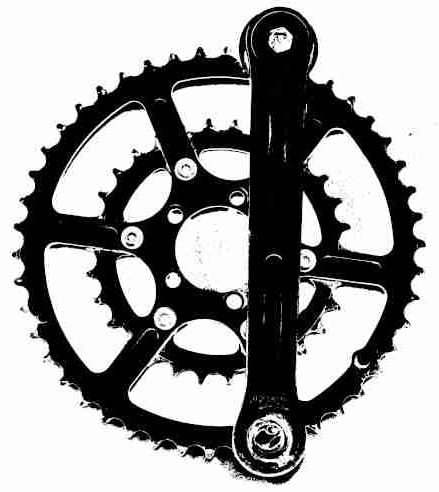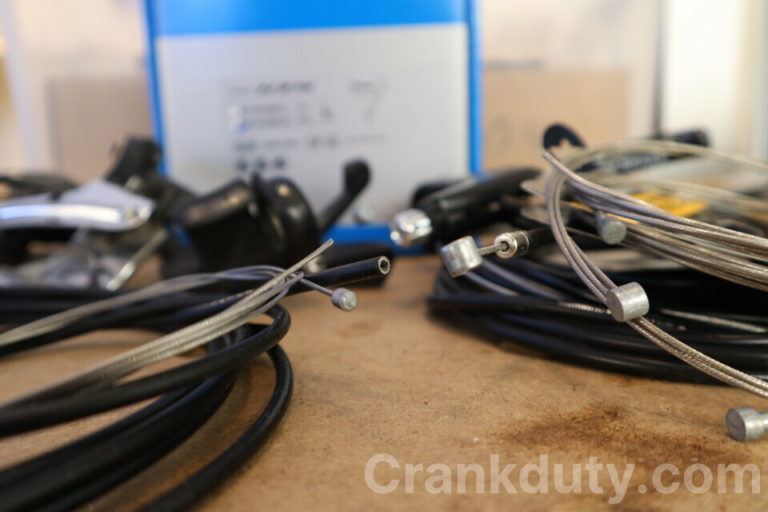Noises from Crankset: 4 Common Causes and Cures
One of the most common small annoyances on the bike are clicking and creaking noises from the direction of the crankset. While often associated with heavy pedaling, in really bad cases these sounds may plague your every pedal stroke.
This article tells you how to spot and fix the four most common issues that produce clicking in the crankset area: loose pedal, loose crank, loose bottom bracket and a cracked chainring. We will also discuss other noise sources which may appear to come from the crankset.
Clicks and creaks are hard to troubleshoot. They are erratic and often weather-dependent, and you cannot really hear where the noise comes from. Fixing them is alchemy: higher torque and “better” thread treatment may cure the click, but sometimes it takes some of the opposite!
But as all other bicycle noises, clicks and creaks from the crankset should always be diagnosed. These are often harmless, but sometimes indications of progressing mechanical fault which may lead to an accident.

Cause 1: Pedal loose in crank
A loose pedal is a common source of clicking noise while pedaling. The pedal does not even have to be very loose in the crank to click – just a bit short of the recommended tightening torque may be enough.
Pedal click is fortunately easy to diagnose and fix. On my own bikes, the pedal has been the number one source of clicking, but the fix has never taken more than a few minutes.
Diagnosis: Grab the pedal by hand. Push the pedal up and down. If the pedal is not tight enough in the crank, this should produce an audible and tactile click.
How to fix: Tighten the pedal to recommended torque. Note that this usually takes either a long pedal wrench or a lot of force.
- If the click persists or the pedal was already at recommended torque, try thread-locking the entire thread length and the contact surface (remove the pedal, clean the threads, apply threadlock, tighten).
- If there was a pedal washer, try removing it and tightening again; if there was no washer, try adding one.
Pedals threaded all the way to the axle shoulder are most likely to click. This is poor design as it prevents proper pre-loading of the joint. Avoid these pedals, and if you cannot, always use a pedal washer.
Cause 2: Crank loose on spindle
Another possible cause of clicking or creaking from the bottom bracket direction is a crank that is not tight enough on the spindle. The pedaling moments are quite high in this joint and even minute movement may produce sound.
Crank attachments vary from square-taper to the modern splined through-axles (Hollowtech II, DUB, Octalink). The creak-prevention measures are still the same: apply grease or anti-seize and tighten to specified torque.
Diagnosis: Grip one crank and the seat tube. Squeeze the crank towards the seat tube. This way you load mainly the crank alone. If you hear of feel a click, the crank is probably the source.
How to fix: Tighten the crank properly. Remove crank, apply anti-seize paste, remount and tighten to specified torque.
Cause 3: Bottom bracket loose in frame
A third source of clicking noise is the bottom bracket being loose in the frame. This issue occurs mostly with threaded bottom brackets – press-fit types are less often affected.
Clicking or creaking can be generated by the bottom bracket moving in the frame just a bit during a powerful pedal stroke. Sometimes this happens despite the BB being tightened to the specified torque.
Bottom bracket clicking is the most insidious and hardest to fix. You always need to remove the cranks to get to the bottom bracket. Getting rid of the click may require repeated tightening and changing the thread treatment from anti-seize to threadlock or PTFE tape.
Diagnosis: Direct testing is difficult. Bottom bracket clicking can be diagnosed by excluding the crank and pedal as sources – see above.
How to fix it: Tighten the bottom bracket to specified torque and/or change the thread treatment. You can use the following “upgrade rules”:
- If you used grease or anti-seize in earlier install, go for low-strength threadlock (e.g. blue Loctite).
- If you already used low-strength threadlock, try a medium-strength grade (e.g. green Loctite)
- From even medium-strength threadlock does not fix the issue, change the tactic: go for grease, anti-seize or PTFE tape.
- See table below:
| THREAD TREATMENT UPGRADING Original: | Change to: |
|---|---|
| grease anti-seize | low-strength threadlock |
| PTFE tape | low-strength threadlock |
| low-strength threadlock | medium-strength threadlock (green) |
| medium threadlock | anti-seize PTFE tape |
Personal note: I have struggled with many persistently creaky bottom brackets – I am a high-torque pedaler which may explain this. Threadlock has solved it in most cases, but once I actually ended up replacing the creaky Shimano cartridge BB with an SKF one. The creak was gone, maybe thanks to tighter tolerances between locking sleeve and the BB body.
Cause 4: Cracked chainring
A rare but possible mechanical issue that may generate clicking noise is a cracked chainring. Unlike the above, this is a real mechanical failure that requires replacing the damaged part. The chainring should be replaced without delay, as it may fail catastrophically under load.
Diagnosis: Clean the chainring(s) and inspect them under good lighting. The crack will be mostly radial and visible to the eye. Pay special attention to pins, inner corners and discontinuities.
How to fix it: Replace the cracked chainrings. (Repairing the cracks is sadly not possible.)
Common features
Regardless of the exact source of crankset noise, there are many features common to all creaks and clicks. It is useful to be aware of them while troubleshooting the noise.
Intermittency: Crankset region clicks and creaks often come and go in a cycle. But a creak going away usually does not mean it’s cured.
The reason to the intermittency is that the clicking and creaking is produced by stick-slip phenomenon which is very sensitive to the conditions in the joint. This applies to the pedal–crank, the crank–spindle and the bottom bracket–shell joints. A slight change and the click goes away – another and it resumes.
Weather-dependency: Humidity and temperature greatly affect the frictional conditions in the joints. This is why crankset clicks are often weather-dependent: your bottom bracket may click only in the summer or winter, or only when it’s very dry.
In general, wet weather tends to suppress clicks and creaks. I assume this is due to moisture lowering the static friction and also damping sudden motions as it has filled most voids.
Unpredictability: It is hard to predict which joints will click or creak. It is also difficult to predict which exact measure will stop them from making noise. The reason to this is the complexities of stick-slip, fit between parts and external loading.
As an example, lowering the friction in the pedal threads by greasing them allows you to get the pedal tighter to the crank with the same torque. However, it also reduces the static and dynamic friction in the joint, making small movements more likely. While initially silent, sometimes this joint will eventually become creaky as the grease loses oils over time. Had the joint been dry to start with, the parts may have settled (partly through corrosion) into a stable, creakless position.
Other issues
Sometimes clicks and creaks that you think are coming from the crankset are not really coming from there. The truth is that it’s difficult to locate a sound source on the bike with certainty.
In case none of the above seem to be the noise source, check for the following issues elsewhere:
Cracked downtube: Aluminum frames in particular are prone to developing fatigue cracks over time. A crack in the downtube can generate a clicking or creaking sound once in a pedal revolution, particularly when standing up.
NB. An “audible” crack is already large and presents an immediate risk of sudden frame failure.
(Personal note: In 2012, I spent weeks fixing a very persistent “bottom bracket creak”. One day while pedaling uphill the noise was suddenly gone, and the bike went wobbly. Explanation: the “BB creak” had actually been a fatigue crack in downtube, which finally went all the way through.)
Loose saddle clamp: Creaking noises from below often originate from the saddle clamp. These can be mistaken for crankset noise. If you have a creak that disappears when you pedal standing up, check the saddle clamp. Fortunately this is an easy one to check and fix.
Parting thoughts
Sheldon Brown’s dictum is worth repeating: a well-functioning bicycle is basically silent. A click or creak – from the crackset or elsewhere – is a sign of a mechanical issue, which, unattended, is only bound to grow.
For the sake of your bike’s and your own health, you should take any sound from your bike seriously and diagnose it without delay.


